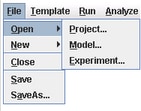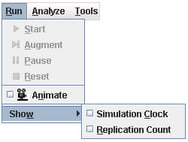The main Simulation Studio menu consists of six items: File, Template, Run, Analyze, Tools, and Help. Use the File menu (shown in Figure 3.4) to open, create, close, and save projects, models, and experiments in Simulation Studio. When you open or create a new project, Simulation Studio opens a new project window in the Project Desktop area of the GUI and updates the Project Explorer accordingly. If this is a new project, a new (empty) model and experiment are also created. When an existing project is opened, all models and experiments in that project are opened and entries are created for them in the Project Explorer.
A Simulation Studio template stores information about a collection of Simulation Studio blocks. Template details are provided in Chapter 11: Block Templates. Use the Template menu to open, create, close, and save Simulation Studio templates. Opening a template adds the template name to the Template list box in the Block Template Display area of the application. You can use this list box to determine which template palette is visible in the Block Template Display area of the application. Select Template→Close to remove the current template name from the Template list box and also remove the associated blocks from the Template palette. Select Save or SaveAs to save the current template to disk storage. More details about templates are provided in Chapter 11: Block Templates.
The Run menu (Figure 3.5) controls much of the model execution and animation. Many of the controls are also found in the toolbar. The functionality associated with model execution controls (Start, Pause, and so on) is discussed in Chapter 4: Simulation Models. Select Show to enable or disable the simulation clock and replication count displays for the current model. When visible, the clock and replication count appear in the upper right corner of an individual Project window.
To access the JMP distribution-fitting platform, select Analyze→Fit Distribution. To open the configuration dialog box (Figure 3.2), select Tools→Configuration.
The toolbar (Figure 3.6) provides quick access to most of the functionality in the Run menu. The animation icon
 acts as a toggle switch for turning execution animation on and off. Clicking an icon in the toolbar invokes the functionality
associated with that icon. The remaining toolbar icons are discussed in Chapter 4: Simulation Models.
acts as a toggle switch for turning execution animation on and off. Clicking an icon in the toolbar invokes the functionality
associated with that icon. The remaining toolbar icons are discussed in Chapter 4: Simulation Models.


